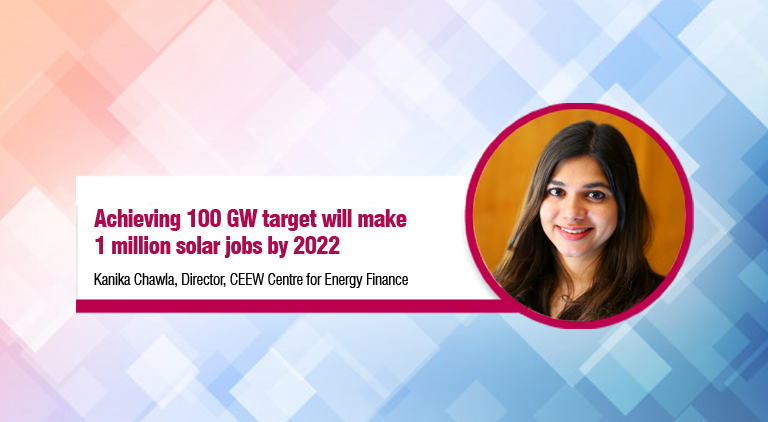Achieving 100 GW target will make 1 million solar jobs by 2022
By EPR Magazine Editorial September 6, 2019 2:15 pm IST
By EPR Magazine Editorial September 6, 2019 2:15 pm IST

Kanika Chawla, Director, CEEW Centre for Energy Finance, an India-based and globally engaged research think-tank, analyses and advises critical questions concerning climate change, energy, and renewable jobs, in an interaction with Athira Bejoy.
What are the major promotional functions of CEEW?
CEEW is a non-profit institution, founded nine years ago. We use data, integrated analysis, and strategic outreach to explain – and change – the use, reuse, and misuse of resources. We work on issues spanning from energy access, renewables, and power sector, to slightly more long term issues such as industrial sustainability, deep decarbonisation scenarios, and climate risks. CEEW also engages extensively with the national and international community on issues under the Montreal Agreement, the Paris Agreement, geo-engineering governance, etc. So, as the name suggests, the work isn’t dedicated to one aspect or any specific sector but it is like a cross-cutting and takes an integrated approach to the several global transitions, be it in energy, mobility, water use, and beyond.
Do you think India is even close to solving the climate change issue, especially when there is no heavy capital flow into it?
There is really no solving for climate change but rather addressing, and controlling the pace of the change and correcting and adapting to the change. We are seeing a rise in climate related disasters, be it in the form of heat and water stress, or through a rapidly rising incidence of natural disasters. Climate action around the world needs to be scaled up if we want to come close to the ambition enshrined in the Paris Agreement. In this context, India has done a commendable job in combining climate action with domestic priorities around industrial growth, job creation, reduction in energy poverty, and enhanced energy security. India’s ambitious and growing clean energy targets display our leadership, acting in line with our commitments under the Paris Agreement. However, that alone is not enough. Even as India offers a growing renewable energy market, one of the largest in the world, there needs to more investment in end use sectors beyond just renewable energy power.
Further, large pools of public investment are going to be required in upgrading the grid infrastructure for integrating the large and growing shares of renewable energy into the grid system. With India’s growing energy demand, there is a huge opportunity for India to power its growth through low carbon technologies, but there is need for growing investments both in R&D and implementation of such technologies.
Renewable energy is supposed to generate almost 3 million jobs by 2030. There are mixed opinions going on about it. What are your views?
CEEW, along with our partners, conducts the only primary survey for job analysis in India. From our survey, we found out that by 2022, 1.1 million jobs (FTE) would be created in the solar sector alone if we realise our 100 GW target. This would translate into a permanent workforce of 330,000 people, and growing. Another important aspect to consider is that the job creation also depends on what kind of renewable energy asset are installed. Decentralised assets, like solar rooftop, generate more jobs as compared to centralised assets like solar power. The differential rate between both can be quite significant; rooftop generates 7 times more jobs/MW than solar power.
How is automation being implemented to reduce energy usage and dynamic load changes and make smarter energy choices?
Automation plays a very large role depending on what level you are planning to implement IT technologies and automation. For example, if it is at the dispatch level for grid management, the grid dispatch managers can use technologies to better plan their dispatch and renewables integration. EESL, is also taking up installation of smart meters at household levels and coupling it with appliance efficiency. So, I think automation and AI could be critical in tying all of these things together.
India is said to touch renewable energy capacity of 260 GW by 2024. What are your views?
We started off at a point with a view of making an advanced market commitment, signalling to industry and investors that India is one of the largest renewable energy markets in the world. This has resulted in an unprecedented pace of growth in the renewable energy sector. So in this context the new targets are an important signal to indicate that the 175GW were a floor, and not the ceiling of our ambition. However, the large ambition must also be matched with regulation keeping pace with policy, and investments in system upgrades and grid infrastructure to ensure that the growth in renewables translates to energy consumption too, and is not limited to just capacity targets.
Large pools of public investment are needed to upgrade the grid infrastructure for integrating large and growing renewable energy shares into the grid system.
Kanika Chawla, Director, CEEW Centre for Energy Finance
We use cookies to personalize your experience. By continuing to visit this website you agree to our Terms & Conditions, Privacy Policy and Cookie Policy.